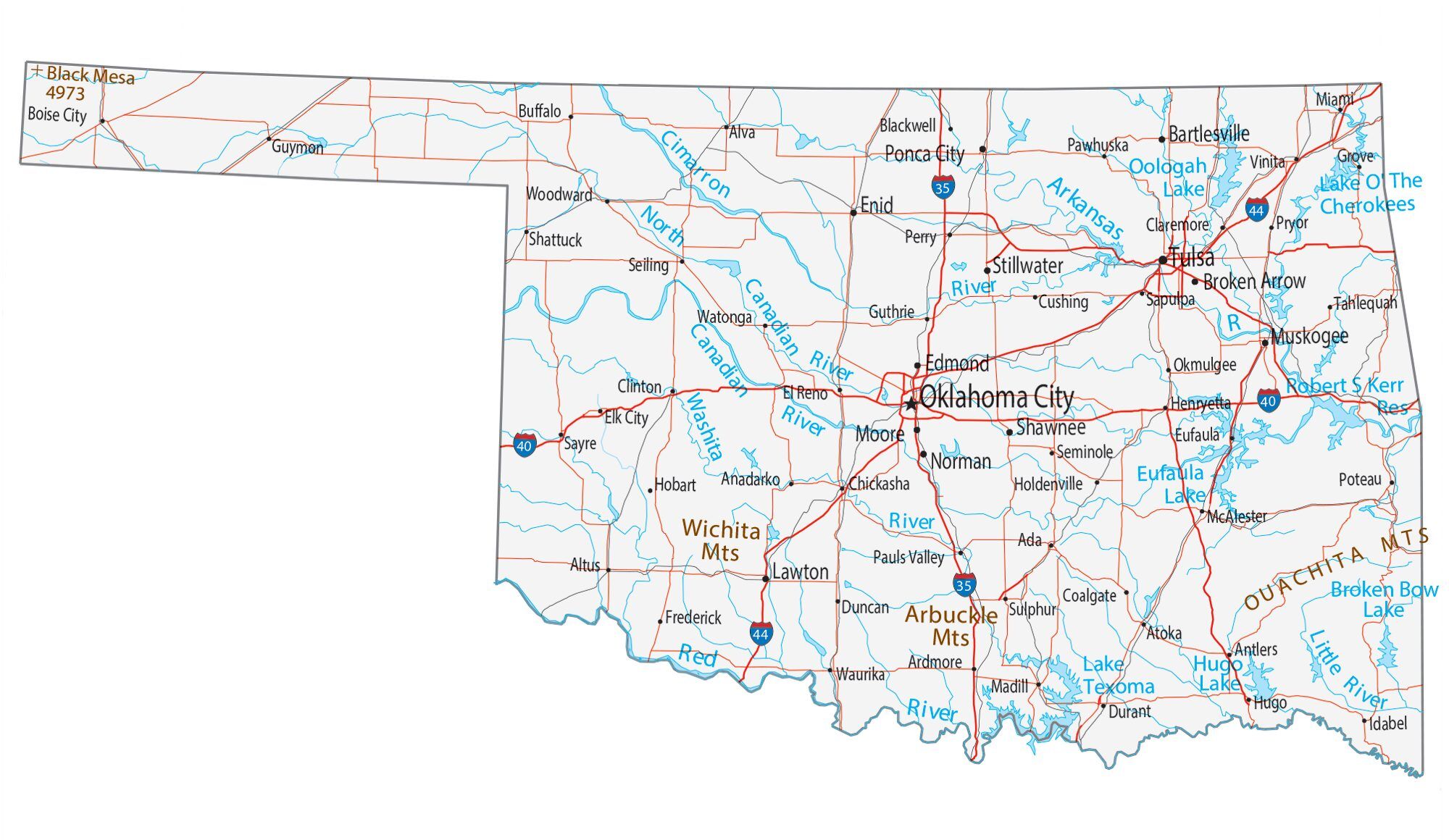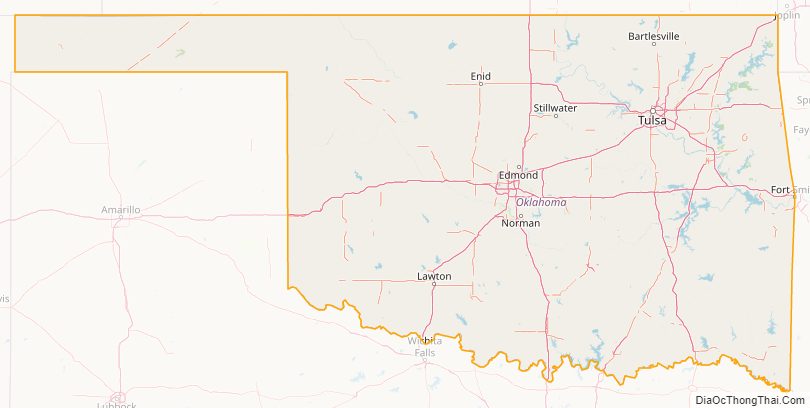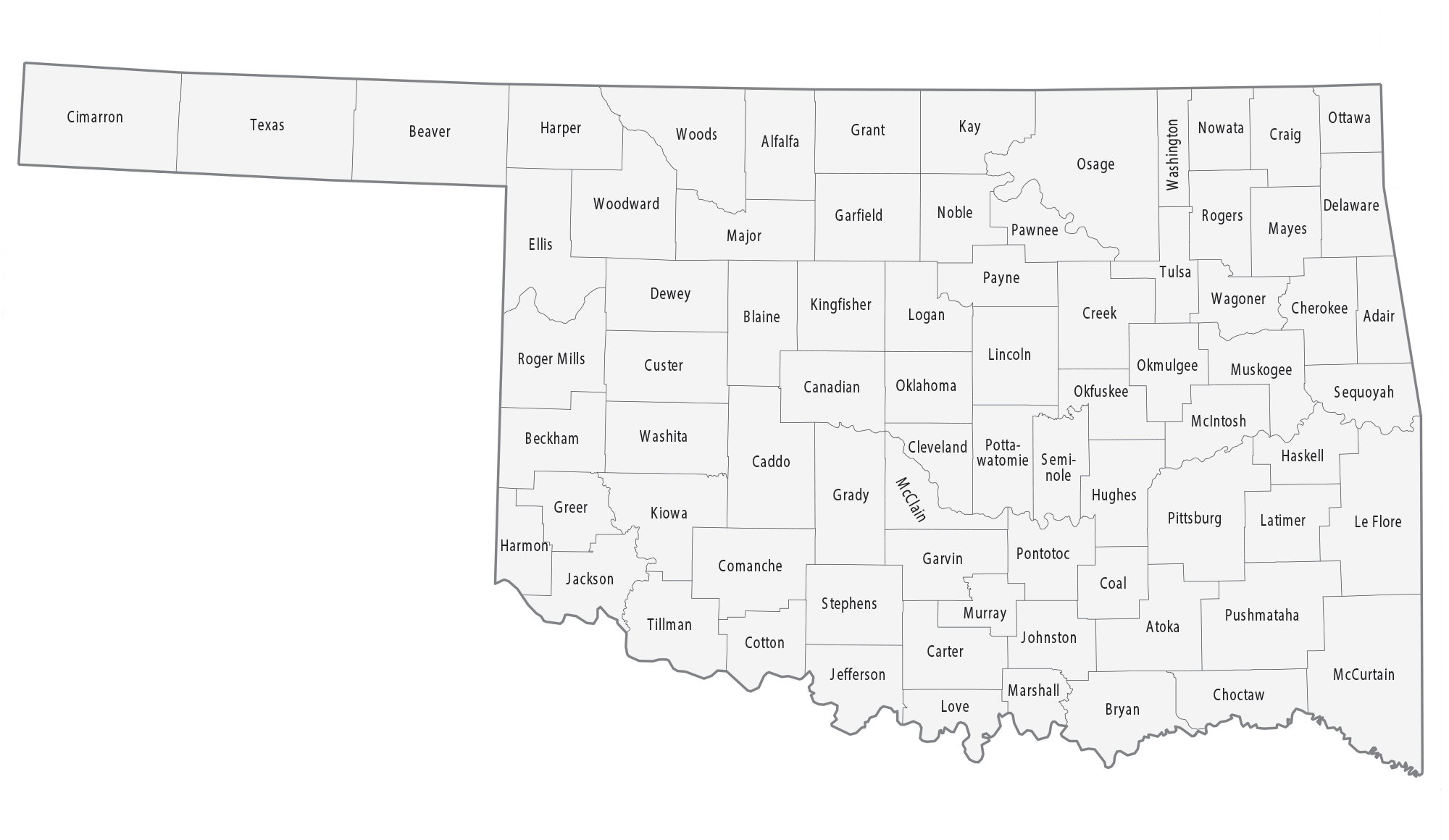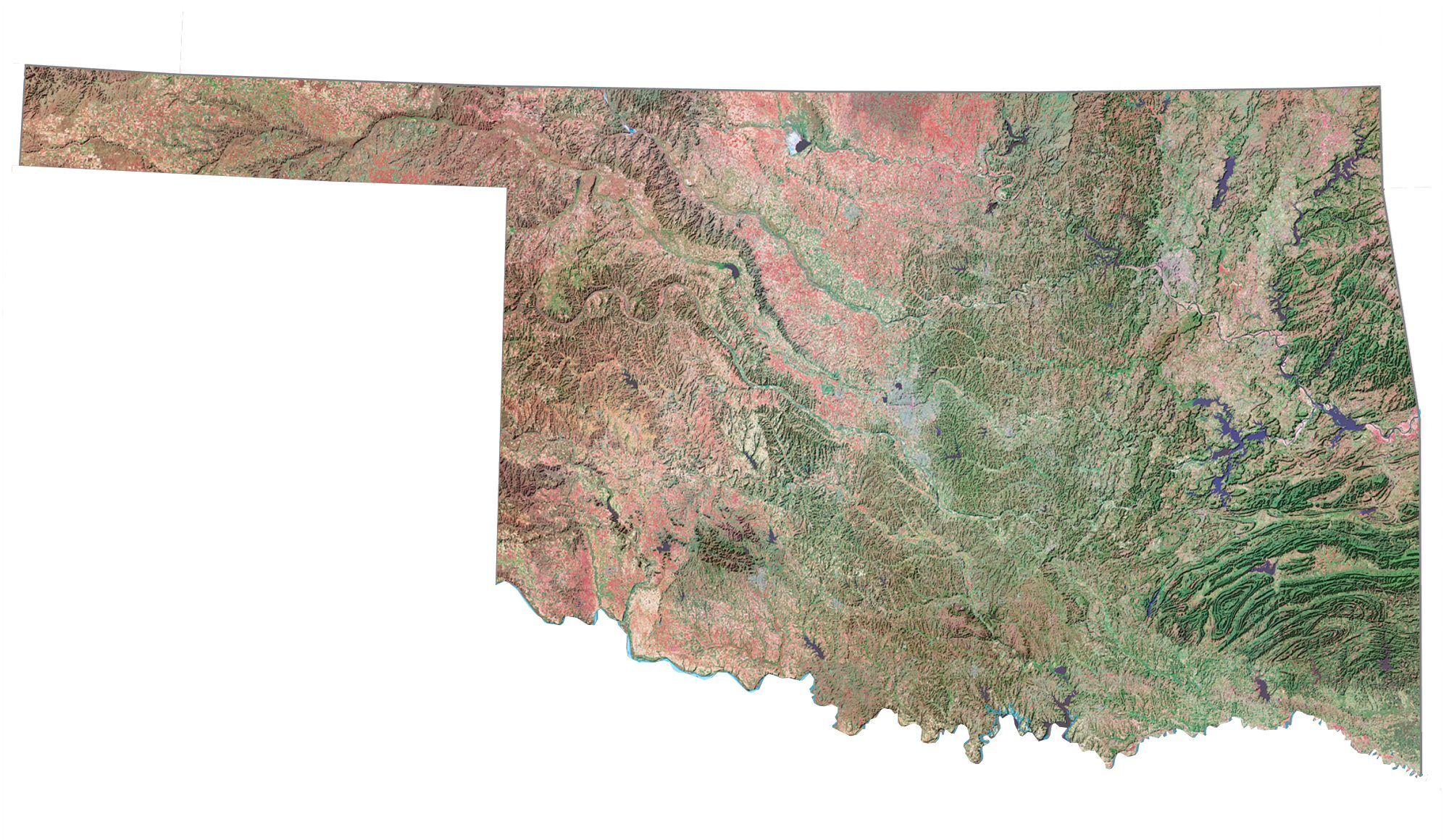Oklahoma (/ˌoʊkləˈhoʊmə/ (listen); Choctaw: Oklahumma [oklahómma]; Cherokee: ᎣᎧᎳᎰᎹ, Okalahoma [ògàlàhǒːmã́]) is a state in the South Central region of the United States, bordered by Texas on the south and west, Kansas on the north, Missouri on the northeast, Arkansas on the east, New Mexico on the west, and Colorado on the northwest. Partially in the western extreme of the Upland South, it is the 20th-most extensive and the 28th-most populous of the 50 United States. Its residents are known as Oklahomans and its capital and largest city is Oklahoma City.
The state’s name is derived from the Choctaw words okla, ‘people’ and humma, which translates as ‘red’. Oklahoma is also known informally by its nickname, “The Sooner State”, in reference to the settlers who staked their claims on land before the official opening date of lands in the western Oklahoma Territory or before the Indian Appropriations Act of 1889, which increased European-American settlement in the eastern Indian Territory. Oklahoma Territory and Indian Territory were merged into the State of Oklahoma when it became the 46th state to enter the union on November 16, 1907.
With ancient mountain ranges, prairie, mesas, and eastern forests, most of Oklahoma lies in the Great Plains, Cross Timbers, and the U.S. Interior Highlands, all regions prone to severe weather. Oklahoma is at a confluence of three major American cultural regions. Historically, it served as a government-sanctioned territory for Native Americans removed from east of the Mississippi River, a route for cattle drives from Texas and related regions, and a destination for Southern settlers. There are currently twenty-five Native American languages still spoken in Oklahoma.
A major producer of natural gas, oil, and agricultural products, Oklahoma relies on an economic base of aviation, energy, telecommunications, and biotechnology. Oklahoma City and Tulsa serve as Oklahoma’s primary economic anchors, with nearly two-thirds of Oklahomans living within their metropolitan statistical areas.
| Before statehood: |
|
|---|---|
| Admitted to the Union: | November 16, 1907; 115 years ago (1907-11-16) (46th) |
| Capital: | Oklahoma City |
| Capital – largest city: | largest city |
| Largest metro and urban areas: | Greater Oklahoma City |
| Elevation: | 1,300 ft (400 m) |
| Total Area: | 69,898 sq mi (181,038 km) |
| Area Rank: | 20th |
| Total Population: | 4,019,800 |
| Population Rank: | 28th |
| Population Density: | 55.20/sq mi (21.30/km) |
| Population Density Rank: | 35th |
| Median Household Income: | $50,051 |
| Income Rank: | 43rd |
| Demonym(s): | Oklahoman; Okie (colloq., historically derogatory); Sooner (historically) |
| USPS abbreviation: | OK |
| ISO 3166 code: | US-OK |
| Website: | www.ok.gov |
Online Interactive Map
Oklahoma location map. Where is Oklahoma state?
Oklahoma Road Map
Oklahoma Map – Roads & Cities
Oklahoma Street Map
History
Settlements
Indigenous peoples were present in what is now Oklahoma by the last ice age. Ancestors of the Wichita and Affiliated Tribes (including Teyas and Escanjaques and Tawakoni), Tonkawa, and Caddo (including Kichai) lived in what is now Oklahoma. Southern Plains villagers lived in the central and west of the state, with a subgroup, the Panhandle culture people, living in the panhandle region. Caddoan Mississippian culture peoples lived in the eastern part of the state. Spiro Mounds, in what is now Spiro, Oklahoma, was a major Mississippian mound complex that flourished between AD 850 and 1450. Plains Apache people settled in the Southern Plains and in Oklahoma between 1300 and 1500.
The Expedition of Spaniard Francisco Vázquez de Coronado traveled through the state in 1541, but French explorers claimed the area in the early 18th century. By the 18th century, Comanche and Kiowa entered the region from the west and Quapaw and Osage peoples moved into what is now eastern Oklahoma. French colonists claimed the region until 1803, when all the French territory west of the Mississippi River was acquired by the United States in the Louisiana Purchase. The territory was a part of the Arkansas Territory from 1819 until 1828.
During the 19th century, the U.S. federal government forcibly removed tens of thousands of Native Americans from their homelands from across North America and transported them to the area including and surrounding present-day Oklahoma. The Choctaw was the first of the Five Civilized Tribes to be removed from the Southeastern United States. The phrase “Trail of Tears” originated from a description of the removal of the Choctaw Nation in 1831, although the term is usually used for the Cherokee removal.
Seventeen thousand Cherokees and 2,000 of their black slaves were deported. The area, already occupied by Osage and Quapaw tribes, was called for the Choctaw Nation until revised Native American and then later American policy redefined the boundaries to include other Native Americans. By 1890, more than 30 Native American nations and tribes had been concentrated on land within Indian Territory or “Indian Country”.
All Five Civilized Tribes supported and signed treaties with the Confederate military during the American Civil War. The Cherokee Nation had an internal civil war. Slavery in Indian Territory was not abolished until 1866.
In the period between 1866 and 1899, cattle ranches in Texas strove to meet the demands for food in eastern cities and railroads in Kansas promised to deliver in a timely manner. Cattle trails and cattle ranches developed as cowboys either drove their product north or settled illegally in Indian Territory. In 1881, four of five major cattle trails on the western frontier traveled through Indian Territory.
Increased presence of white settlers in Indian Territory prompted the United States Government to establish the Dawes Act in 1887, which divided the lands of individual tribes into allotments for individual families, encouraging farming and private land ownership among Native Americans but expropriating land to the federal government. In the process, railroad companies took nearly half of Indian-held land within the territory for outside settlers and for purchase.
Major land runs, including the Land Run of 1889, were held for settlers where certain territories were opened to settlement starting at a precise time. Usually land was open to settlers on a first come first served basis. Those who broke the rules by crossing the border into the territory before the official opening time were said to have been crossing the border sooner, leading to the term sooners, which eventually became the state’s official nickname. Deliberations to make the territory into a state began near the end of the 19th century, when the Curtis Act continued the allotment of Indian tribal land.
20th and 21st centuries
Attempts to create an all-Indian state named Oklahoma and a later attempt to create an all-Indian state named Sequoyah failed but the Sequoyah Statehood Convention of 1905 eventually laid the groundwork for the Oklahoma Statehood Convention, which took place two years later. On June 16, 1906, Congress enacted a statute authorizing the people of the Oklahoma and Indian Territories (as well what would become the states of Arizona and New Mexico) to form a constitution and state government in order to be admitted as a state. On November 16, 1907, President Theodore Roosevelt issued Presidential Proclamation no. 780, establishing Oklahoma as the 46th state in the Union.
The new state became a focal point for the emerging oil industry, as discoveries of oil pools prompted towns to grow rapidly in population and wealth. Tulsa eventually became known as the “Oil Capital of the World” for most of the 20th century and oil investments fueled much of the state’s early economy. In 1927, Oklahoman businessman Cyrus Avery, known as the “Father of Route 66”, began the campaign to create U.S. Route 66. Using a stretch of highway from Amarillo, Texas to Tulsa, Oklahoma to form the original portion of Highway 66, Avery spearheaded the creation of the U.S. Highway 66 Association to oversee the planning of Route 66, based in his hometown of Tulsa.
Oklahoma also has a rich African-American history. Many Black towns, founded by the Freedmen of the Five Tribes during Reconstruction, thrived in the early 20th century with the arrival of Black Exodusters who migrated from neighboring states, especially Kansas. The politician Edward P. McCabe encouraged Black settlers to come to what was then Indian Territory. McCabe discussed with President Theodore Roosevelt the possibility of making Oklahoma a majority-Black state.
By the early 20th century, the Greenwood district of Tulsa was one of the most prosperous African-American communities in the United States. Jim Crow laws had established racial segregation since before the start of the 20th century, but Tulsa’s Black residents had created a thriving area.
Social tensions were exacerbated by the revival of the Ku Klux Klan after 1915. The Tulsa race massacre broke out in 1921, with White mobs attacking Black people and carrying out a pogrom in Greenwood. In one of the costliest episodes of racist violence in American history, sixteen hours of rioting resulted in the destruction of 35 city blocks, $1.8 million in property damage, and an estimated death toll of between 75 and 300 people. By the late 1920s, the Ku Klux Klan had declined to negligible influence within the state.
During the 1930s, parts of the state began to suffer from the consequences of poor farming practices. This period was known as the Dust Bowl, throughout which areas of Kansas, Texas, New Mexico and northwestern Oklahoma were hampered by long periods of little rainfall, strong winds, abnormally high temperatures, and most notably, severe dust storms sending thousands of farmers into poverty and forcing them to relocate to more fertile areas of the western United States. Over a twenty-year period ending in 1950, the state saw its only historical decline in population, dropping 6.9 percent as impoverished families migrated out of the state after the Dust Bowl.
Soil and water conservation projects markedly changed practices in the state and led to the construction of massive flood control systems and dams; they built hundreds of reservoirs and man-made lakes to supply water for domestic needs and agricultural irrigation. By the 1960s, Oklahoma had created more than 200 lakes, the most in the nation.
In 1995, Oklahoma City was the site of the most destructive act of domestic terrorism in American history. The Oklahoma City bombing of April 19, 1995, in which Timothy McVeigh detonated a large, crude explosive device outside the Alfred P. Murrah Federal Building, killed 168 people, including 19 children. For his crime, McVeigh was executed by the federal government on June 11, 2001. His accomplice, Terry Nichols, is serving life in prison without parole for helping plan the attack and prepare the explosive.
On May 31, 2016, several cities experienced record setting flooding.
On July 9, 2020, the Supreme Court of the United States determined in McGirt v. Oklahoma that the reservations of the Five Tribes, comprising much of Eastern Oklahoma, were never disestablished by Congress and thus are still “Indian Country” for the purposes of criminal law.
Oklahoma State Map – Places and Landmarks
Oklahoma Political Map
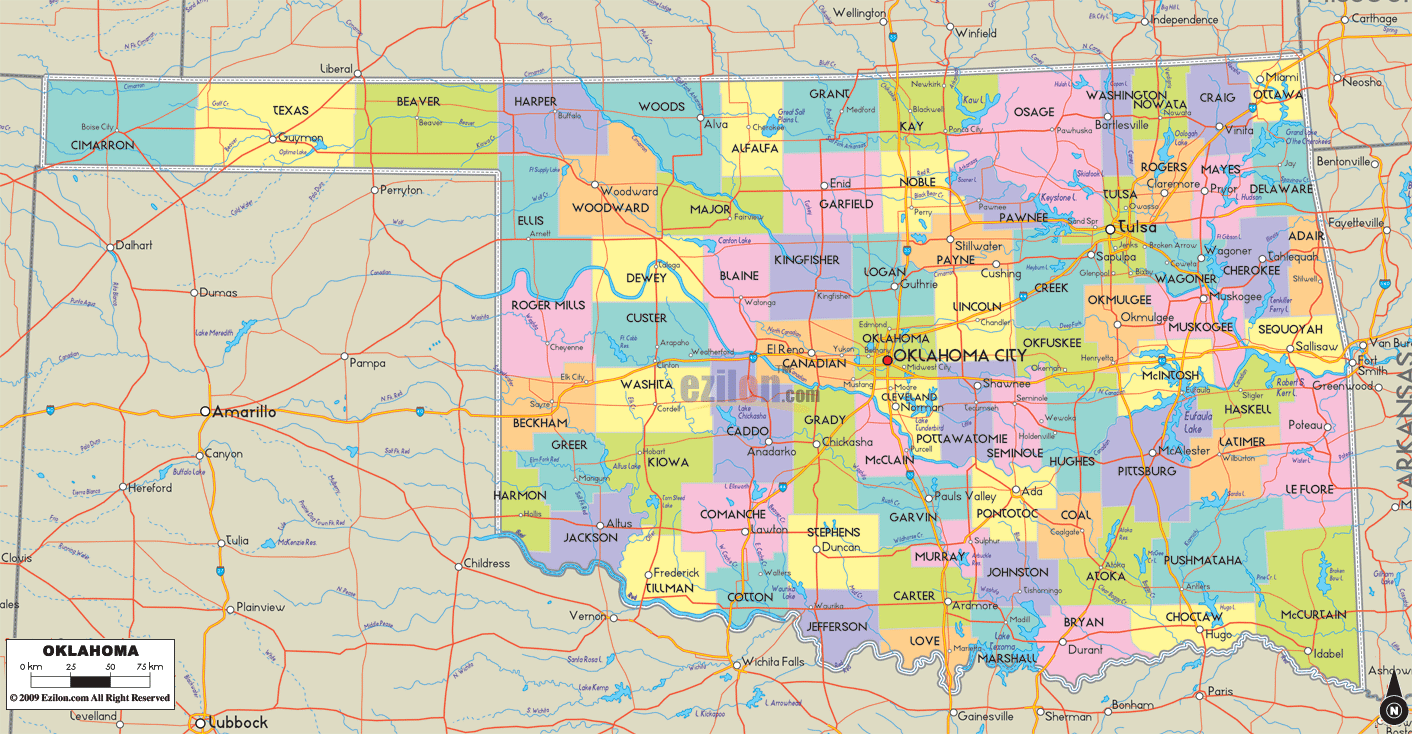
Oklahoma Lakes and Rivers Map
Oklahoma Physical Map
Oklahoma Topographic Map
Oklahoma Satellite Map
Others printable maps
Oklahoma Outline Map
Blank Oklahoma County Map
See also
Map of Oklahoma State and its subdivision:- Adair
- Alfalfa
- Atoka
- Beaver
- Beckham
- Blaine
- Bryan
- Caddo
- Canadian
- Carter
- Cherokee
- Choctaw
- Cimarron
- Cleveland
- Coal
- Comanche
- Cotton
- Craig
- Creek
- Custer
- Delaware
- Dewey
- Ellis
- Garfield
- Garvin
- Grady
- Grant
- Greer
- Harmon
- Harper
- Haskell
- Hughes
- Jackson
- Jefferson
- Johnston
- Kay
- Kingfisher
- Kiowa
- Latimer
- Le Flore
- Lincoln
- Logan
- Love
- Major
- Marshall
- Mayes
- McClain
- McCurtain
- McIntosh
- Murray
- Muskogee
- Noble
- Nowata
- Okfuskee
- Oklahoma
- Okmulgee
- Osage
- Ottawa
- Pawnee
- Payne
- Pittsburg
- Pontotoc
- Pottawatomie
- Pushmataha
- Roger Mills
- Rogers
- Seminole
- Sequoyah
- Stephens
- Texas
- Tillman
- Tulsa
- Wagoner
- Washington
- Washita
- Woods
- Woodward
- Alabama
- Alaska
- Arizona
- Arkansas
- California
- Colorado
- Connecticut
- Delaware
- District of Columbia
- Florida
- Georgia
- Hawaii
- Idaho
- Illinois
- Indiana
- Iowa
- Kansas
- Kentucky
- Louisiana
- Maine
- Maryland
- Massachusetts
- Michigan
- Minnesota
- Mississippi
- Missouri
- Montana
- Nebraska
- Nevada
- New Hampshire
- New Jersey
- New Mexico
- New York
- North Carolina
- North Dakota
- Ohio
- Oklahoma
- Oregon
- Pennsylvania
- Rhode Island
- South Carolina
- South Dakota
- Tennessee
- Texas
- Utah
- Vermont
- Virginia
- Washington
- West Virginia
- Wisconsin
- Wyoming


